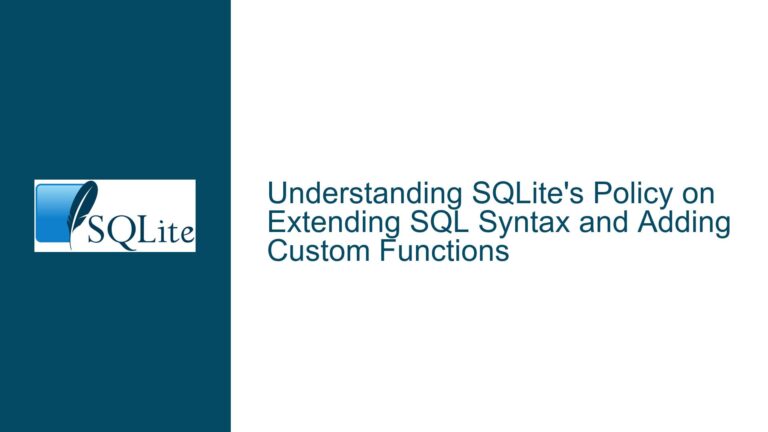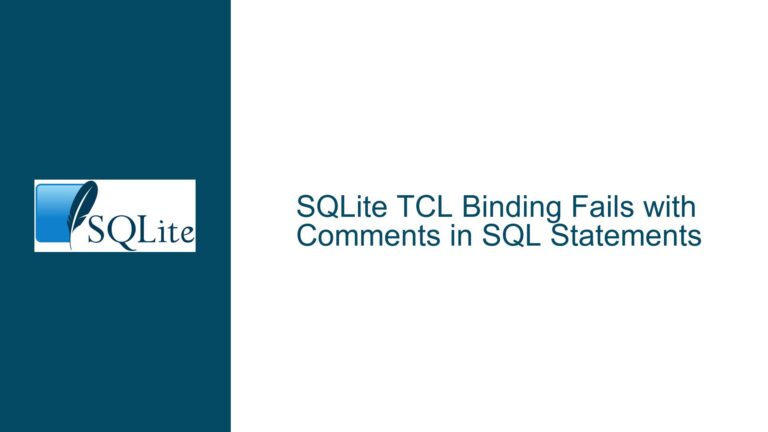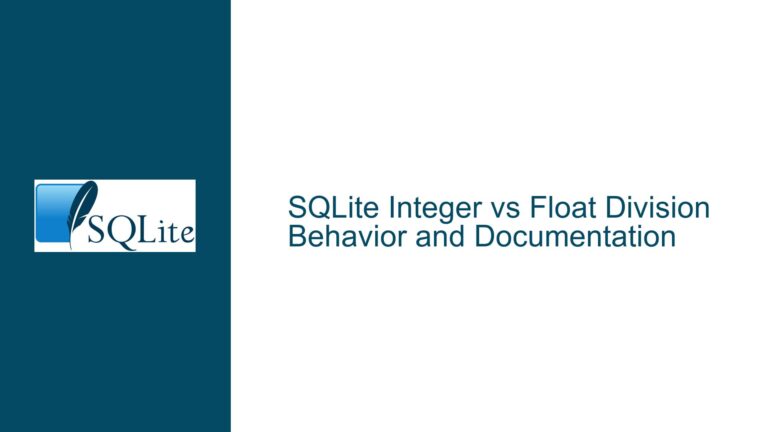SQLite Missing GROUP BY ROLLUP: Impacts and Workarounds
Understanding the Absence of ROLLUP Functionality in SQLite and Its Consequences
Issue Overview: The Limitations of SQLite’s GROUP BY Clause Without ROLLUP
SQLite’s GROUP BY clause is a foundational tool for aggregating data into summary rows. However, unlike PostgreSQL, MySQL, and other relational databases, SQLite does not natively support the ROLLUP modifier for GROUP BY. This omission creates challenges for users who require hierarchical or multi-level subtotals in aggregated reports.
What is ROLLUP?
The ROLLUP modifier extends the GROUP BY clause by generating super-aggregate rows that represent subtotals and grand totals across specified dimensions. For example, in a sales dataset grouped by brand and segment, ROLLUP would produce:
- Aggregates for each
(brand, segment)pair. - Subtotals for each
brand(aggregating allsegmentvalues). - A grand total for the entire dataset.
Example Scenario
Consider a sales table with columns brand, segment, and quantity. A query using ROLLUP in PostgreSQL would generate the following output:
SELECT brand, segment, SUM(quantity)
FROM sales
GROUP BY ROLLUP (brand, segment);
This returns rows for:
- Individual brand-segment combinations.
- Subtotals per brand (with
segmentasNULL). - A grand total (both
brandandsegmentasNULL).
SQLite’s Limitation
In SQLite, attempting to use ROLLUP results in a parse error:
sqlite> SELECT brand, segment, SUM(quantity) FROM sales GROUP BY ROLLUP(brand, segment);
Parse error: no such function: ROLLUP
To replicate this functionality, users must manually combine multiple GROUP BY queries using UNION ALL, which introduces complexity and performance overhead.
Why This Matters
- Performance: The
ROLLUPmodifier in other databases computes all aggregation levels in a single table scan. SQLite’s workaround requires multiple scans (one perGROUP BYlevel), which becomes inefficient for large datasets. - Code Maintainability: Manually writing
UNION ALLqueries for multi-level aggregations is error-prone, especially when dealing with many columns or nested hierarchies. - Standardization: Analysts and developers accustomed to
ROLLUPin other systems face a learning curve when adapting to SQLite’s limitations.
Root Causes: Why SQLite Lacks Native ROLLUP Support
1. Design Philosophy and Use Case Prioritization
SQLite prioritizes simplicity, minimal resource usage, and broad compatibility over feature completeness for specialized use cases. Its core design targets embedded systems, IoT devices, and applications where a lightweight, serverless database is critical. Features like ROLLUP, which are more aligned with OLAP (Online Analytical Processing) workloads, have historically been deprioritized in favor of optimizing for OLTP (Online Transaction Processing).
Key Trade-offs:
- Binary Size: Adding
ROLLUPwould increase SQLite’s codebase size, conflicting with its goal of remaining a compact library (<1 MB in default configurations). - Execution Complexity: Implementing
ROLLUPrequires significant changes to the query planner and execution engine to handle multi-level aggregations efficiently.
2. Technical Challenges in Implementation
The ROLLUP modifier is not merely syntactic sugar; it requires deep integration with the query optimizer to avoid redundant computations. For example, in PostgreSQL, ROLLUP leverages grouping sets—a lower-level abstraction that defines multiple grouping criteria in one pass.
SQLite’s Aggregation Engine:
SQLite’s current aggregation logic processes GROUP BY by sorting or hashing rows based on the grouping columns. Adding ROLLUP would necessitate:
- Tracking multiple grouping levels simultaneously.
- Generating
NULLplaceholders for super-aggregate rows. - Ensuring compatibility with existing features like
HAVINGandORDER BY.
3. Community and Development Priorities
The SQLite development team operates conservatively, focusing on stability and backward compatibility. Feature requests undergo rigorous scrutiny to ensure they align with the project’s long-term goals. While user demand for ROLLUP exists, it has not yet reached critical mass to justify prioritization over other enhancements or bug fixes.
Community Contributions:
SQLite’s codebase is open-source, but contributions are tightly controlled. Implementing a feature as complex as ROLLUP would require a well-tested patch that adheres to the project’s coding standards—a high barrier for external contributors.
Strategies for Emulating ROLLUP in SQLite and Mitigating Performance Issues
Workaround 1: Manual Aggregation with UNION ALL
The most straightforward method to replicate ROLLUP is to combine multiple GROUP BY queries using UNION ALL:
-- Individual brand-segment aggregates
SELECT brand, segment, SUM(quantity)
FROM sales
GROUP BY brand, segment
UNION ALL
-- Brand-level subtotals
SELECT brand, NULL, SUM(quantity)
FROM sales
GROUP BY brand
UNION ALL
-- Segment-level subtotals (if needed)
SELECT NULL, segment, SUM(quantity)
FROM sales
GROUP BY segment
UNION ALL
-- Grand total
SELECT NULL, NULL, SUM(quantity)
FROM sales
ORDER BY brand, segment;
Advantages:
- Clear and explicit control over aggregation levels.
- Works in all SQLite versions.
Drawbacks:
- Multiple Table Scans: Each
UNION ALLsegment executes independently, scanning the entire table. For large datasets, this leads to significant I/O and CPU overhead. - Maintenance Burden: Adding or modifying grouping columns requires updating all
UNION ALLclauses, increasing the risk of inconsistencies.
Workaround 2: Materialized Views for Common Aggregations
For frequently used rollups, precompute and store aggregated results in temporary or materialized views:
CREATE TEMPORARY VIEW brand_segment_agg AS
SELECT brand, segment, SUM(quantity) AS total
FROM sales
GROUP BY brand, segment;
CREATE TEMPORARY VIEW brand_agg AS
SELECT brand, NULL AS segment, SUM(quantity) AS total
FROM sales
GROUP BY brand;
-- Combine with UNION ALL as before
Advantages:
- Reduces redundant computation for repeated queries.
- Simplifies complex aggregation logic.
Drawbacks:
- Temporary views are session-specific and must be recreated on each connection.
- Storage overhead for materialized results.
Optimization 1: Indexing for Faster Aggregation
To mitigate the performance impact of multiple scans, create indexes tailored to the grouping columns:
CREATE INDEX idx_sales_brand_segment ON sales(brand, segment);
CREATE INDEX idx_sales_brand ON sales(brand);
CREATE INDEX idx_sales_segment ON sales(segment);
How It Helps:
- Indexes allow the query planner to retrieve grouped data without full table scans.
- Covering indexes (including
quantity) can further speed up aggregation:CREATE INDEX idx_sales_covering ON sales(brand, segment, quantity);
Optimization 2: Using Common Table Expressions (CTEs)
CTEs improve readability and may help the query planner optimize execution:
WITH
base AS (SELECT brand, segment, quantity FROM sales),
brand_segment AS (
SELECT brand, segment, SUM(quantity) AS total
FROM base
GROUP BY brand, segment
),
brand_total AS (
SELECT brand, NULL AS segment, SUM(quantity) AS total
FROM base
GROUP BY brand
),
grand_total AS (
SELECT NULL AS brand, NULL AS segment, SUM(quantity) AS total
FROM base
)
SELECT * FROM brand_segment
UNION ALL
SELECT * FROM brand_total
UNION ALL
SELECT * FROM grand_total
ORDER BY brand, segment;
Advantages:
- Centralizes data sourcing in the
baseCTE, reducing redundancy. - May enable the query planner to reuse intermediate results (though SQLite’s CTE optimization is limited).
Alternative Approach: Application-Side Aggregation
For applications with access to the host programming language (e.g., Python, Java), offload aggregation logic:
- Retrieve raw data:
SELECT brand, segment, quantity FROM sales; - Compute aggregates programmatically using dictionaries or arrays.
Example in Python:
import sqlite3
from collections import defaultdict
conn = sqlite3.connect('sales.db')
cursor = conn.cursor()
cursor.execute("SELECT brand, segment, quantity FROM sales")
rows = cursor.fetchall()
brand_segment = defaultdict(int)
brand_total = defaultdict(int)
segment_total = defaultdict(int)
grand_total = 0
for brand, segment, qty in rows:
brand_segment[(brand, segment)] += qty
brand_total[brand] += qty
segment_total[segment] += qty
grand_total += qty
# Generate output
output = []
for (brand, segment), total in brand_segment.items():
output.append((brand, segment, total))
for brand, total in brand_total.items():
output.append((brand, None, total))
for segment, total in segment_total.items():
output.append((None, segment, total))
output.append((None, None, grand_total))
# Sort and print
output.sort(key=lambda x: (str(x[0]), str(x[1])))
for row in output:
print(row)
Advantages:
- Single table scan.
- Flexibility to handle complex aggregation logic.
Drawbacks:
- Requires additional application code.
- Not feasible for ad-hoc SQL queries.
Long-Term Solution: Advocate for Native ROLLUP Support
While workarounds exist, advocating for native ROLLUP implementation in SQLite can yield long-term benefits:
- Submit a Feature Request: File a detailed proposal on the SQLite Forum outlining use cases and performance benchmarks.
- Community Engagement: Rally support from other users facing similar challenges to demonstrate demand.
- Explore Forks or Extensions: Investigate SQLite forks like DuckDB, which prioritize analytical workloads and already support
ROLLUP.
DuckDB Example:
-- DuckDB supports ROLLUP natively
SELECT brand, segment, SUM(quantity)
FROM sales
GROUP BY ROLLUP (brand, segment);
Considerations When Switching:
- DuckDB’s Limitations: As noted in the forum discussion, DuckDB’s in-memory architecture may not suit datasets exceeding available RAM.
- SQL Compatibility: Verify that other critical SQLite features are supported before migrating.
Conclusion
The absence of GROUP BY ROLLUP in SQLite necessitates creative workarounds, each with trade-offs in performance, maintainability, and complexity. By combining UNION ALL queries, optimizing indexes, or offloading aggregation to application code, users can approximate the functionality of ROLLUP while awaiting potential future enhancements. For analytical workloads requiring frequent hierarchical aggregations, evaluating alternatives like DuckDB may provide a more sustainable path forward.






